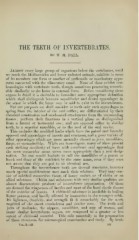Page 327 - My FlipBook
P. 327
THE TEETH OF INVERTEBRATES.
By W. H. DALL.
Almost every large group of organisms below the vertebrates, until
we reach the Molluscoidea and lower radiated animals, exhibits in some
of its members one form or another of j)rehensile or raasticatory appa-
ratus connected with the alimentary canal. None of these exhibit true
homologies with vertebrate teeth, though sometimes presenting remark-
able similarity to the latter in external form. Before considering these
organs in detail it is desirable to formulate some appropriate definition
which shall distinguish between mandibular and dental appendages in
the sense in wliich the latter may be said to exist in the invertebrates.
For our purposes we shall consider as teeth only such appendages as
spring from the interior of the oral orifice ; are clitferentiated by their
chemical constitution and mechanical attachments from the surrounding
tissues ; perform their functions in a vertical plane as distinguished
from a lateral or horizontal one ; and are opposed either to similar
teeth, to a superior mandible, or to the roof of the oral cavity.
This excludes the modified limbs which form the paired and laterally
opposed oral appendages of insects and Crustacea, and a great variety of
other appendages which are more naturally classed as jaws, mandibles,
fangs, or stomacholiths. While not homologous, many of these present
such striking similarity of form with vertebrate oral appendages that
the same vernacular name seems more appropriate than a new desig-
nation. No one would hesitate to call the mandibles of a parrot or
hawk and those of the cuttlefish by the same name, even if they were
not aware that they are put to an identical use.
Throughout the invertebrates teeth are dermal structures, however
much special modifications may mask their relations. They may con-
sist of calcified connective tissue, of horny matter, or of chitin or an
allied substance. Chitin and substances with very similar qualities are
almost characteristic products of invertebrate organization. Of them
are formed the wing-cases of beetles and most of the hard elastic tissues
of the exterior of insects. A chitinoid substance is insoluble in boiling
liquor potassoe, and hardly affected by immersion in the strongest acids.
Its lightness, elasticity, and strength fit it remarkably for the work
required of the insect exoskeleton and similar uses. The teeth and
jaws of mollusks, the nippers, mandibles, and setse of worms, and
many similar invertebrate organs, are composed to a greater or less
extent of chitinoid material. This aids materially in the preparation
of these structures for microscopical examination and study. By heatr
Vol. I.—22 337


